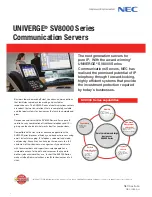
486
IBM z13s Technical Guide
SMC-R requires the following software:
z/OS V2R1 (with PTFs) or higher are the only supported operating systems for the SMC-R
protocol. You cannot roll back to previous z/OS releases.
z/OS guests under z/VM 6.3 are supported to use 10GbE RoCE features
IBM is working with its Linux distribution partners to include support in future Linux on
z Systems distribution releases.
Other RoCE considerations
The following are other consideration when using RoCE:
RoCE system limits:
– 16 Physical cards per CPC (no change from zEC12)
– 31 Virtual Functions per PCHID
– 128 unique VLANs per PCHID physical port
– Each VF guaranteed minimum of 2 VLANs with a maximum of 16 (31 VFs, and the
maximum number of VLANs depends on the number of unique VLAN IDs)
z/OS CS consumption of RoCE virtual resources:
– One VF consumed per TCP stack (per PCIe function ID (PFID) / port).
– One virtual message authentication code (VMAC) per VF (z/OS uses PF generated
VMAC)
– One VLAN ID (up to 16) per OSA VLAN (“inherited” as TCP connections occur)
z/OS Communications Server Migration considerations:
– RoCE HCD (IOCDS) configuration changes are required
– Existing z/OS RoCE users might be required to make a TCP/IP configuration change
(that is, existing TCP/IP profile (PFIDs) might be compatible with shared RoCE)
Changes are required for existing RoCE users for the following cases:
– z/OS users who use multiple TCP/IP stacks and both stacks currently use the same
RoCE feature (single z/OS image sharing a physical card among multiple stacks).
– z/OS users who need to use both physical RoCE ports from the same z/OS instance
(not “best practices”, but is allowed).
– z/OS users who could not continue using (coordinate) the same PFID values (continue
using the existing PFID value used in the dedicated environment for a specific z/OS
instance) when adding multiple PFIDs and VFs to the same card (for additional shared
users).
D.2.10 SMC-R use cases for z/OS to z/OS
SMC-R with RoCE provides high-speed communications and “HiperSockets like”
performance across physical processors. It can help all TCP-based communications across
z/OS LPARs that are in different CPCs.
The following list shows several typical communications patterns:
Optimized Sysplex Distributor intra-sysplex load balancing
WebSphere Application Server type 4 connections to remote DB2, IMS, and CICS
instances
IBM Cognos® to DB2 connectivity
Summary of Contents for z13s
Page 2: ......
Page 3: ...International Technical Support Organization IBM z13s Technical Guide June 2016 SG24 8294 00 ...
Page 24: ...THIS PAGE INTENTIONALLY LEFT BLANK ...
Page 164: ...136 IBM z13s Technical Guide ...
Page 226: ...198 IBM z13s Technical Guide ...
Page 256: ...228 IBM z13s Technical Guide ...
Page 414: ...386 IBM z13s Technical Guide ...
Page 464: ...436 IBM z13s Technical Guide ...
Page 476: ...448 IBM z13s Technical Guide ...
Page 498: ...470 IBM z13s Technical Guide ...
Page 502: ...474 IBM z13s Technical Guide ...
Page 568: ...540 IBM z13s Technical Guide ...
Page 578: ...550 IBM z13s Technical Guide ...
Page 584: ...556 IBM z13s Technical Guide ...
Page 585: ...ISBN 0738441678 SG24 8294 00 1 0 spine 0 875 1 498 460 788 pages IBM z13s Technical Guide ...
Page 586: ......
Page 587: ......
Page 588: ...ibm com redbooks Printed in U S A Back cover ISBN 0738441678 SG24 8294 00 ...














































